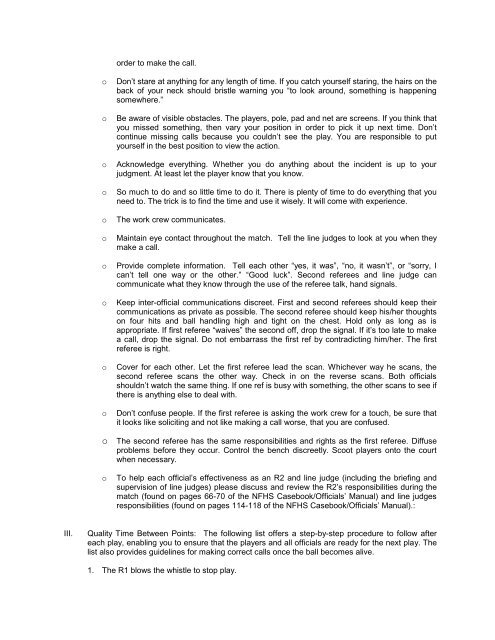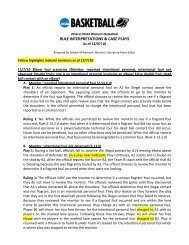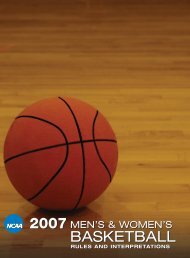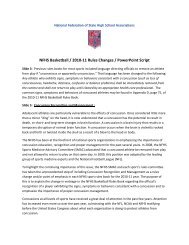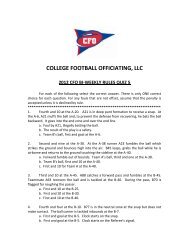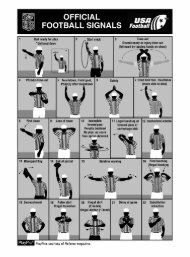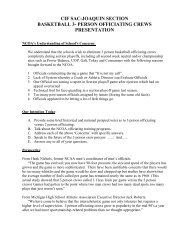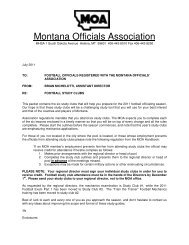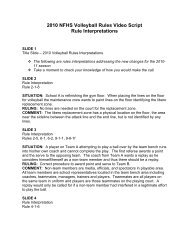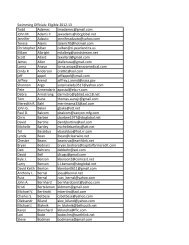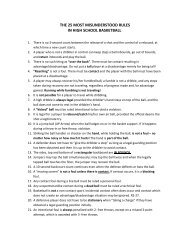order to make the call.ooooooooooDon’t stare at anything for any length of time. If you catch yourself staring, the hairs on theback of your neck should bristle warning you “to look around, something is happeningsomewhere.”Be aware of visible obstacles. The players, pole, pad and net are screens. If you think thatyou missed something, then vary your position in order to pick it up next time. Don’tcontinue missing calls because you couldn’t see the play. You are responsible to putyourself in the best position to view the action.Acknowledge everything. Whether you do anything about the incident is up to yourjudgment. At least let the player know that you know.So much to do and so little time to do it. There is plenty of time to do everything that youneed to. The trick is to find the time and use it wisely. It will come with experience.The work crew communicates.Maintain eye contact throughout the match. Tell the line judges to look at you when theymake a call.Provide complete information. Tell each other “yes, it was”, “no, it wasn’t”, or “sorry, Ican’t tell one way or the other.” “Good luck”. Second referees and line judge cancommunicate what they know through the use of the referee talk, hand signals.Keep inter-official communications discreet. First and second referees should keep theircommunications as private as possible. The second referee should keep his/her thoughtson four hits and ball handling high and tight on the chest. Hold only as long as isappropriate. If first referee “waives” the second off, drop the signal. If it’s too late to makea call, drop the signal. Do not embarrass the first ref by contradicting him/her. The firstreferee is right.Cover for each other. Let the first referee lead the scan. Whichever way he scans, thesecond referee scans the other way. Check in on the reverse scans. Both officialsshouldn’t watch the same thing. If one ref is busy with something, the other scans to see ifthere is anything else to deal with.Don’t confuse people. If the first referee is asking the work crew for a touch, be sure thatit looks like soliciting and not like making a call worse, that you are confused.o The second referee has the same responsibilities and rights as the first referee. Diffuseproblems before they occur. Control the bench discreetly. Scoot players onto the courtwhen necessary.oTo help each official’s effectiveness as an R2 and line judge (including the briefing andsupervision of line judges) please discuss and review the R2’s responsibilities during thematch (found on pages 66-70 of the NFHS Casebook/Officials’ Manual) and line judgesresponsibilities (found on pages 114-118 of the NFHS Casebook/Officials’ Manual).:III.Quality Time Between Points: The following list offers a step-by-step procedure to follow aftereach play, enabling you to ensure that the players and all officials are ready for the next play. Thelist also provides guidelines for making correct calls once the ball becomes alive.1. The R1 blows the whistle to stop play.
Note: Make eye contact with the R2. That should be done before signaling the result of theplay (point or replay) in case the R2 blew a simultaneous whistle or called a different fault. Bychecking with your partner immediately when play ends, you avoid potential embarrassmentand won’t have to reverse a decision. That is also the time to make eye contact with linejudges if there was a possibility of a touch.2. Indicate the result: Point, side out or play over.3. Signal the fault (ball hitting the floor, illegal contact, etc.). When necessary, you may need toverbalize the fault, i.e., to clarify a decision or in the rare case where a signal doesn’t exist,such as interfering with a ball in play under the net. In some cases it may be necessary tovisually indicate who committed the fault but pointing at the player who commits a violation isnot preferred.Note: The first three steps are done separately, not simultaneously.4. Check the scorer’s table. You’re right, that isn’t your responsibility. However, by ensuring thatthe scorer added one to the scoreboard after a point or didn’t add a point you will eliminate thechance of a coach thinking they’re being jobbed out of a point.5. Check both benches. That applies to the R1 and the R2. Has a team just reeled off a fewpoints? Expect a timeout. Is the tiny setter moving to the front row? There might be asubstitution. Anticipating coaches’ requests keeps the game moving and makes it appear as ifyou know what’s going on. It’s also a courtesy that most coaches appreciate, even expect.6. Check players’ positions. That’s crucial for at least two reasons:a. The R1 is responsible for calling serving team overlaps; the R2 is responsible forreceiving team. To accomplish that, you must know each player’s spot in the rotation.b. Equally important is being prepared to call back-row attack or blocker violations. Beforeeach point, know if each team’s setter is front row or the back row. The R1 can check theserving team’s side; the R2 checks the receiving team (he/she will then relay the info. Tothe R1: see No. 8 below).Also, if a team’s offense frequently uses an attacker from the back row, or if they haveone “go to” player who gets set all around the court, before the play starts you should beaware of which hitters will have to take off from behind the attack line.7. Check the receiving team’s readiness. Allow ample time for them to get ready for the nextplay but don’t allow unnecessary delays. A coach yelling out instructions to a player is not areason to delay play. On the other hand, it is proper to allow a player running back onto thecourt a second to figure out her spot in the rotation.Also, visually ensure that the line judge is in position. Often the line judge will disappear tochase down a ball and will take their time returning.8. Look at the R2. Ensure your partner is in position and ready for the next play. The R2 can nowbe signaling the position of the receiving team’s setter. A typical signal is for the R2 todiscreetly point across the stomach toward the end line if the setter is in the back row ortoward the net if the setter is in the front row.That’s also the time for the R2 to communicate other signals (game/match point, etc.), give ayellow-card or red-card warning for a conduct violation or to tighten-up ball handling. You andyour partner can work out your own signals, but keep the subtle.9. Check the serving team’s readiness. They should be ready as soon as the receiving team, butthe serving team might take an extra moment due to a celebration over the last point or toallow the server to get ready. Again, use your peripheral vision to ensure that the line judge isin position on the side of the court.10. Blow the whistle and beckon the next serve.Keep in mind that all of the above things should be done within a few seconds so you don’t disruptthe flow of the game. With a little practice it’s easy to do and in no time it will feel like a naturalpart of your officiating. The few extra seconds of work between points is quality time wisely spentand it will enhance the quality of your matches.


